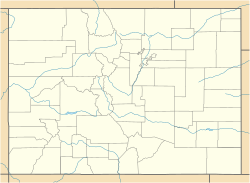Boggsville is an extinct town located in Bent County, Colorado, United States. The town was located near the Purgatoire River about 3 miles (4.8 km) above the Purgatoire's confluence with the Arkansas River. It lies along Highway 101 about 2 miles south of Las Animas.
Boggsville, Colorado | |
|---|---|
Location within Bent County and Colorado | |
| Coordinates: 38°02′30″N 103°12′46″W / 38.0417°N 103.2127°W | |
| Country | United States |
| State | Colorado |
| County | Bent |
| Elevation | 3,914 ft (1,193 m) |
| Time zone | UTC−7 (MST) |
| • Summer (DST) | UTC−6 (MDT) |
| ZIP Code | 81054 (Las Animas)[1] |
| Area code | 719 |
Boggsville | |
 The Boggs House | |
| Location | S. of Las Animas on SH 101, Las Animas, Colorado |
| Area | 39 acres (16 ha) |
| Built | 1866 |
| Architectural style | Territorial style |
| NRHP reference No. | 86002841[2] (original) 100005980 (increase) |
| CSRHP No. | 5BN.363 |
| Significant dates | |
| Added to NRHP | October 24, 1986 |
| Boundary increase | May 23, 2022 |
History
editIt was established in 1866. The surviving structures are among the earliest examples of Territorial architecture in Colorado. Boggsville was the last home of frontiersman Kit Carson before his death in 1868 at Fort Lyon.
The village was a stagecoach station on the Purgatory Branch of the Santa Fe Trail. With the establishment of Bent County in 1870, Boggsville became the county seat. The town was named for Thomas Oliver Boggs (1824-1894), an Indian trader from the Indian Territory and cattle dealer. In 1846 Boggs married 14-year-old Rumalda Luna Bent, the stepdaughter of Charles Bent, first American governor of New Mexico, who was an heiress to land grants in Colorado. In 1866 Boggs built an adobe house on the 2,040 acres (830 ha) grant. The next year John Wesley Prowers built a two-story 14-room house at Boggsville that functioned as a house, a school, a stagecoach station, and after 1870 as the Bent County seat.[3]
In 1867 the citizens of Boggsville dug the Tarbox Ditch from the Purgatoire 7 miles (11 km) to about 1,000 acres (400 ha) of irrigated land. The ditch was the first such irrigation project in southeastern Colorado.[3]
In 1873 the county seat was relocated to Las Animas City. At that time Boggsville had 97 voting citizens. The same year, the town was bypassed by the Atchison, Topeka and Santa Fe Railway and the Kansas Pacific Railroad. Prowers moved to West Las Animas and became a cattle rancher and politician. Boggs, who was the first sheriff of Bent County and who was elected to the territorial legislature in 1871, moved to Springer, New Mexico in 1877 after his wife's land grants were contested. After the departure of Prowers and Boggs the property was sold, becoming the San Patricio Ranch of 3,000 acres (1,200 ha) under the Lee family.[3]
The U.S. Post Office at Las Animas (ZIP Code 81054) now serves Boggsville postal addresses.[1]
Description
editThe Boggsville site is at the center of a large farm, of which 39 acres (16 ha) were donated to the Pioneer Historical Society of Bent County containing the Boggs and Prowers houses, which are the only remaining historic structures. There had been at one time thirteen permanent buildings in the village, one of which was the home of Kit Carson from December 1867 until Carson's death in May 1868. The Carson House was destroyed in a 1921 flood.[3]
The Boggs House has been unoccupied since 1975. It is U-shaped but was originally L-shaped. The one-story adobe structure combines features of Territorial architecture and Greek Revival characteristics. The Prowers House was last inhabited in the 1950s The rectangular house was partly collapsed by the 1980s, with portions removed as early as the 1920s. The Powers House is adobe, with interior woodwork brought to the site from St. Louis. There are a further five outbuildings associated with the Boggs House.[3][4]
The Boggs and Prowers houses have been restored by the Pioneer Historical Society of Bent County, and the site is open to the public.[4] Boggsville was placed on the National Register of Historic Places on October 24, 1986.[2]
Notable persons
edit- Kit Carson, frontiersman, fur trapper, wilderness guide, Indian agent, and U.S. Army officer.
- Amache Prowers, Native American activist, cattle rancher, advocate, and storeowner.
See also
editReferences
edit- ^ a b "ZIP Code Lookup". United States Postal Service. January 3, 2007. Archived from the original (JavaScript/HTML) on September 3, 2007. Retrieved January 3, 2007.
- ^ a b "National Register Information System". National Register of Historic Places. National Park Service. July 9, 2010.
- ^ a b c d e McKenzie, William H. (February 7, 1986). "National Register of Historic Places Inventory - Nomination Form: Boggsville". National Park Service. Retrieved July 26, 2012.
- ^ a b Jackson, Billie (2003). "Boggsville Historic Site". Pioneer Historical Society of Bent County. Archived from the original on February 14, 2004.
External links
edit- State of Colorado
- Boggsville Historic Site at the Pioneer Historical Society of Bent County
- Explore Southeast Colorado: Boggsville Historic Site

